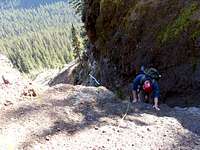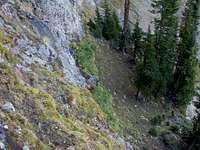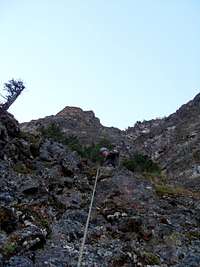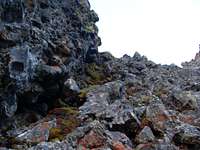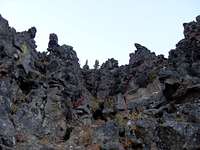|
|
Route |
|---|---|
|
|
45.41650°N / 110.96848°W |
|
|
Trad Climbing |
|
|
Summer |
|
|
A long day |
|
|
5.9 (YDS) |
|
|
5.9 R IV |
|
|
12 |
|
|
IV |
|
|
Overview
The Dark Side of the Moon route on Maid of the Mist Mountain is the second route done on its enormous East Face. In November 2008, Whit Magro and Adam Knoff climbed the first route they called 'Maiden Voyage' at M5 R towards the right side of the face. The face is typical Hyalite rock - rotten and falling apart. Dark Side of the Moon follows the strongest rock on the left side with a fair amount of traversing to reach parts of the face where the rock is strong enough to climb on, which makes for a long day ending in a spectacular summit.Approach
Begin at the Grotto Falls trailhead in Hyalite Canyon. Hike on the easy trail 2-3 miles to the Silken Skein Falls turnoff. Turn right and bushwack to the river, walk across the giant log, then aim straight towards the center of the Face. Head up a steep gully with no trees for a somewhat easy and straightforward approach. When you get to the lower cliff band, head a bit to the right to a large overhang with a comfortable place to gear up.Route Description
Pitch 1: 4th class, 40m
Begin from the cave and traverse to the left across the cliffs around the corner to a nice ledge next to the grassy area.
Pitch 2: 3rd class, 40-60m
Head down the grassy area to another long ledge and continue on the ledge. The 3rd pitch heads straight up the rock, so stop this pitch wherever you want to head up.
An alternative to the first two pitches is two start inside a large chimney at the base of the grassy area instead of the cave. Head up the chimney and left to the long ledge.
Pitch 3: 5.3, 60m
Head up the rock wherever you decide to the large basin above. No protection, but the pitch is very easy and straightforward, so have a competent leader for this one. Belay at a group of trees.
From here, hike up easy 2nd class terrain to the base of the cliff. The route heads up to the left from here to the large ledges with big trees.
Pitch 4: 5.5, 60m
Climb the short, steep rock to the ledge and traverse as far as you can for the belay. After the steep rock it is easy terrain, almost trail-like, though exposed at times.
Pitch 5: 5.6, 45m
Finish the traverse over until you see a tree directly above some 20m. Climb up and belay on the small ledge right of the tree.
Pitch 6: 5.6, 40m
Follow the easiest way up on flowing rock, mostly very loose. Belay from the large tree on a comfortable ledge
Pitch 7: 5.7+, 45m
Climb up a steep section to a grove of trees. Head left after passing thru the trees and climb up any path to a ledge just right of some overhanging boulders. Belay on this ledge. There are comfortable places to sit down and rest at this belay.
Pitch 8: 5.9, 30m
This pitch is the crux of the climb. Climb up any of several possible paths on a 20-foot wide wall, none of which are clean and all will pull down a great amount of loose rock, moss, etc. The easiest, at around 5.9, starts a few feet to the right of the belay and veers left as you climb. The pitch may not look as difficult as it is, however the wall is overhanging about 10 degrees. Belay on the huge ledge directly above this crux wall.
Pitch 9: 5.6, 60m
From the belay, head left traversing on easy terrain to a chimney formed by a 15-foot tall pillar. Either climb up left of the chimney (runout) or head up the crack on the right side. From this crack, make an exposed step to the top of the pillar. Cautiously make a second exposed step to easier ground. Continue all the way over to the end of the ledge to belay. This belay will be at the bottom of a right-facing chimney.
Pitch 10: 5.6, 40m
Climb up inside the right-facing chimney or on the face to the right up towards the top of an arete. Belay anywhere at or near the top of this arete.
Pitch 11: 5.3-5.4, 50m
Follow the arete towards the north-west. Take the obvious path to the left when the arete comes to an end, turning into vertical/overhanging rock. Go across the easier terrain nearly a full rope length to the final chimney. Depending on which traverse ledge you take, it may be easier or harder. Stay high for the easiest path.
Pitch 12: 5.6, 40m
Climb up the rock, inside one of the few chimneys or on one of the faces, to a large area with trees. All options are about equal, so follow the protection because it will be slim. Belay off of any of these trees.
From the top of pitch 12, it is an easy hike up ~100 meters to the summit.
Descent: Follow the standard descent to the west and turn south to come back around the mountain.
NOTE: This route is full of loose rock, moss, and very little protection - thus giving it the R safety rating. Be very efficient at using tricams, as they work the best in the rock of the face.
Essential Gear
Nuts and tricams are a must for this climb. Cams are useful in some spots but not very many.Miscellaneous Info
- The first ascent was done September 27, 2009 in an 18-hour car-to-car day by two college students, age 19 and 20.- Dark Side of the Moon is the only route on the face during the summer. Whit Magro and Adam Knoff made the first ascent of the face on 'Maiden Voyage' (M5 R), which is the only route on the face during the winter, in November 2008




